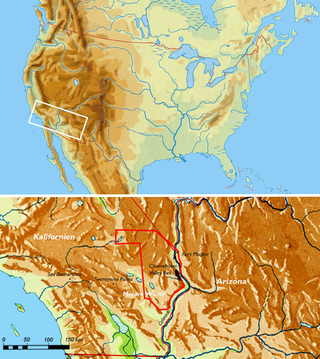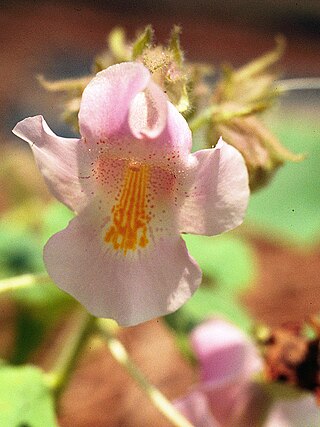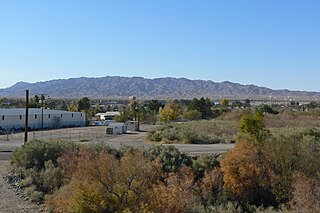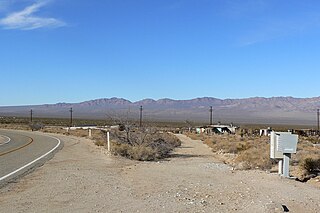
The Chemehuevi are an indigenous people of the Great Basin. They are the southernmost branch of Southern Paiute. Today, Chemehuevi people are enrolled in the following federally recognized tribes:

Proboscidea is a genus of flowering plant in the family Martyniaceae, some of whose species are known as devil's claw, devil's horn, ram's horn, or unicorn plant. The plants produce long, hooked seed pods. The hooks catch on the feet of animals, and as the animals walk, the pods are ground or crushed open, dispersing the seeds. The name devil's claw is shared with the South African plant Harpagophytum procumbens.

The Chemehuevi Indian Tribe of the Chemehuevi Reservation is a federally recognized tribe of Chemehuevi people, who are the southernmost branch of Southern Paiute people.

The Sheep Hole Mountains are a mountain range in the Mojave Desert, to the north of Joshua Tree National Park, in San Bernardino County, California. The mountains were once Chemehuevi hunting grounds.

The Chemehuevi Mountains are a mountain range that are found at the southeast border of San Bernardino County in southeastern California and are adjacent the Colorado River. Located south of Needles, California and northwest of the Whipple Mountains, the mountains are oriented in a north–south direction, and stretch for approximately 15 miles (24 km) in length.

The Sacramento Mountains are a mountain range in the Eastern Mojave Desert and within Mojave Trails National Monument, in San Bernardino County, California.

The Colorado River Indian Tribes is a federally recognized tribe consisting of the four distinct ethnic groups associated with the Colorado River Indian Reservation: the Mohave, Chemehuevi, Hopi, and Navajo. The tribe has about 4,277 enrolled members. A total population of 9,485 currently resides within the tribal reservation according to the 2012-2016 American Community Survey data.
Chemehuevi Valley Airport is a public airport located four miles (6.4 km) north of Chemehuevi Valley, serving as one of two airports in the Lake Havasu City, Arizona, United States metropolitan area. The airport is mostly used for general aviation.
Chemehuevi traditional narratives include myths, legends, tales, and oral histories preserved by the Chemehuevi people of the Mojave Desert and Colorado River of southeastern California and western Arizona.
Carobeth (Tucker) Laird was an American ethnographer and linguist, known for her memoirs and ethnographic studies of the Chemehuevi people in southeastern California and western Arizona. Her book, The Chemehuevis, was characterized by ethnographer Lowell John Bean as "one of the finest, most detailed ethnographies ever written." Her memoirs, Encounter with an Angry God and Limbo, chronicled her first marriage to linguistic anthropologist John P. Harrington and her time in a nursing home, respectively.

Colorado River Numic, of the Numic branch of the Uto-Aztecan language family, is a dialect chain that stretches from southeastern California to Colorado. Individual dialects are Chemehuevi, which is in danger of extinction, Southern Paiute, and Ute. According to the Ethnologue, there were a little less than two thousand speakers of Colorado River Numic Language in 1990, or around 40% out of an ethnic population of 5,000.

Havasu Lake is an unincorporated community in San Bernardino County, California, United States, located on Lake Havasu on the Chemehuevi Reservation in the Mojave Desert. The community serves as the seat of the tribal government of the Chemehuevi Indian Tribe and is home to the Havasu Landing Casino.

Ivanpah is in the Mojave National Preserve in San Bernardino County, California. There are several residences in the area, but no real village.
The Twenty-Nine Palms Band of Mission Indians of California is a federally recognized tribe of Mission Indians with a reservation consisting of two sections, one located near the cities of Indio and Coachella in Riverside County, and the other in the city of Twentynine Palms in San Bernardino County, California. While many scholars regard the tribe as being Luiseño, the tribe itself identifies as being Chemehuevi.

The Chemehuevi Wash is a large wash of northeast San Bernardino County in the southeast Mojave Desert. The wash enters the center-west bank of Lake Havasu on the California–Arizona border. Chemehuevi Wash drains the center of the Chemehuevi Valley and the regional landforms of washes, valleys and mountains is adjacent the northeast region of the Colorado Desert, the entire region south on the west side of the south-flowing Colorado River.

The Palo Verde Valley is located in the Lower Colorado River Valley, next to the eastern border of Southern California with Arizona, United States. It is located on the Colorado Desert within the Sonoran Desert south of the Parker Valley. Most of the valley is in Riverside County, with the southern remainder in Imperial County. La Paz County borders to the east on the Colorado River.
Cara Romero is an American photographer known for her digital photography that examines Indigenous life through a contemporary lens. She lives in both Santa Fe, New Mexico and the Mojave Desert. She is an enrolled citizen of the Chemehuevi Indian Tribe.
Ammoplanus is a genus of aphid wasps in the family Ammoplanidae. There are more than 50 described species in Ammoplanus.
Ammoplanus quabajai is a species of aphid wasp in the family Ammoplanidae. It is found in North America.
Margaret Press is a forensic genealogist and an author of both true crime and mystery novels. She is also known for co-founding the DNA Doe Project with Colleen M. Fitzpatrick.










